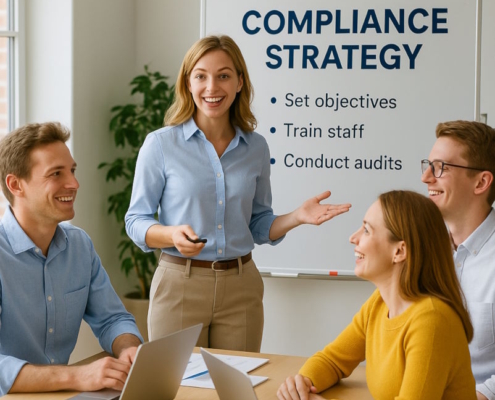Important learnings
- In addition to helping security teams remain on top of regulatory obligations, a compliance strategy serves as a framework for tracking and completing compliance duties.
- You need to establish your objectives, create policies, monitor non-compliance fields, train staff, carry out internal audits, and keep an eye out for advancements in order to create a compliance strategy.
- By streamlining processes using relevant tools, assisting with policies and training, automating the gathering of evidence, and automating a variety of tasks, compliance automation technologies can assist you in implementing your compliance strategy.
Compliance Strategy: What is it?
A compliance strategy refers to a set of rules and activities aimed at decreasing corporate risks, complying with the law, and preventing data leaks. Such strategies are dynamic as they change with new risks and emerging social conditions, and technological advances.
Requirements of the firm that can be determined by any change in the wave of technology, ethical dilemma, market fluctuations, risk behavior, and new rules should be considered during the development of the compliance strategies.
Why should a compliance strategy be created?
To limit the incidence of non-compliance and implement a methodical approach to regulatory and compliance obligations, organizations must create a compliance strategy. Businesses of all sizes must do this, but startups trying to comply or those operating in sectors where laws are frequently enacted or changed should pay particular attention.
- It assists compliance teams and internal functions in implementing new controls, updating rules, and staying ahead of statutory requirements.
- It reduces redundancy and improves operational efficiency by providing clarification on compliance tasks.
- Because it enables staff members to comprehend their responsibilities and contribute significantly, a well-designed compliance management plan also serves as the cornerstone for expediting company expansion.
How to design a compliance strategy
The industry, sector, and compliance structure you select should all be taken into consideration while developing your strategy. To get the compliance planning started, follow these six easy steps:
- Clearly state your aims and objectives
The primary step to guaranteeing success is setting goals. This is an important component of your compliance puzzle since it helps prioritize tasks, establishes openness, and provides a clear sense of direction for all parties involved.
In order to improve accountability and effectively explain your goals, you should establish OKRs (objective key results).
The objection section is a data-supported, action-oriented assessment of your desired outcome. The main results outline your desired outcome, its success percentage, and how you plan to accomplish it within a given time frame. Make sure your aims are in line with the framework’s goals and rules.
You would like to adjust your goals in accordance with changes in compliance goals. Ideally, quarterly or every 6 months.
- Draft procedures and policies
The written rules and processes pertaining to your regulatory duties and responsibilities are known as compliance policies. They highlight your commitment & seriousness to carrying out the plan and provide specifics on how to reach the compliance strategy goals in an organized/professional manner.
The policies should reflect both the culture of the organization and important laws or compliance rules, including ISO 27001 & SOC 2. Enlighten your employees and other concerned individuals about the obligations, responsibilities, and the consequences of non-observance of every policy. These must be revised and amended as necessary.
Policies would help you automate your business as well as create an effective compliance program. But it takes too long to create them by hand, and it is hard to get them right.
We advise adopting a pre-built, readily usable repository of compliance template rules that can be tailored to your needs and cover a variety of regulatory frameworks. You can have complete control over your records, proof, and acknowledgments with the aid of a policy management system.
- Keep a watch on and record non-compliance
It’s essential to keep an eye on your systems and controls for non-compliance, risky conduct, and efficacy after they’re operational. In order to prevent you from going out of compliance, this also lets you monitor how effectively your compliance strategy satisfies the legal requirements and identify any gaps.
The nature and complexity of the company, as well as the regulatory requirements, should be taken into consideration when designing your compliance monitoring plan. To handle vulnerabilities in real time, it should be able to detect, notify, and remediate them.
To automate the processes, think about utilizing a compliance monitoring tool. The fully automated surveillance program helps you achieve comprehensive and ongoing compliance. Using intelligent workflows, provide an overview of hazard controls and procedures in relation to the specifications of the frameworks you have chosen.
- Educate staff
Three elements are necessary for a good compliance strategy: people, procedures, and tools. People should have the necessary skills and knowledge to guarantee the effectiveness of the procedures and equipment. For this reason, companies should devote time and money to help staff members develop a compliance culture.
But that’s easier said than done when it comes to employee training. Individuals often oppose change or pick up new knowledge that isn’t relevant to their everyday tasks. To make sure that your stakeholders and workers are aware of their unique responsibilities, it is your responsibility as an employer to create engaging strategies.
The chosen compliance framework and rules should be the focus of the training course. New and current staff members, senior management, and even outside vendors should be a part of the program.
- Perform audits and keep track of operations
Documentation is a must if you wish to gather evidence of compliance. “If it has not been documented, it is not done” is a viewpoint that all auditors would agree with. Therefore, keep an audit record for everything you do, including putting new controls in place, assigning fresh duties, onboarding new suppliers, taking remedial action, updating systems, and performing risk assessments.
The process of gathering evidence is ongoing and can be either automated or done by hand. A third-party service provider or an internal audit may be used to carry out the final audit. Frameworks such as SOC 2 and ISO 27001 require external audits, which are more thorough because the final report does not include prejudice.
- Constant observation and enhancement
Implementing controls and passing audit checks are only the beginning of your compliance responsibilities; it is an ongoing process rather than a focused one.
Finding new gaps, adhering to evolving regulatory standards, and tackling emerging threat concerns all depend on ongoing monitoring. It assists you in assessing how well your controls are working. By filling in the gaps right away as they appear, you can prevent possible non-compliance situations and avoid fines.
Users must constantly monitor their ISMS (information security management system) in accordance with ISO 27001 standards, which include clauses 10.1 on continuous improvement and 10.2 on nonconformity & corrective action.
Advantages of putting the proper compliance strategy into practice
In addition to encouraging accountability inside the company, a compliance strategy is essential to the long-term viability of compliance initiatives. It adds to the organization’s long-term success and establishes the framework for governance. A few advantages of putting the appropriate compliance plan into practice are as follows:
1. Reduction of risks
Planned implementation minimizes the chances of failure to comply and also the chances of penalties, such as the occurrence of fines and lawsuits. Besides operating risk and damage to reputation, these consequences have a domino effect. By improving your regulatory preparation, a strategy helps you address these issues.
2. Improved public opinion
Compliance has become the norm as more companies strive to attract enterprise and international clientele. The likelihood of closing the sale is increased when you have a documented compliance strategy & program in place, which shows that you consider data protection seriously.
3. Financial gains
The financial advantages that come with a compliance strategy are multifaceted. These include expenses avoided through resource optimization brought about by more efficient operations and streamlined procedures. Then, if the business can show that it has a good compliance plan, it can save money on insurance costs.
4. Better decisions
A roadmap for risk management and routinely assessing compliance performance is provided by the compliance management strategy. Frequent reporting and monitoring benefit top management by giving them clear protocols and offering a thorough picture of the compliance status.
Three tools to assist you with automating compliance
You can easily begin the activities outlined in the strategy with the aid of compliance automation technologies. They can handle all the labor-intensive tasks for your company and optimize compliance operations.
Let’s examine three tools that can assist you with compliance automation:
- Sprinto
Adaptive automation features in Sprinto, a compliance automation platform, let you reduce human involvement while increasing production. It is designed for adaptability, scaling, and maintainability, making it a popular option for cloud-first businesses. With Sprinto’s support for over 20 frameworks, you may prepare for an audit in a matter of weeks rather than months.
Features
- Comprehensive risk management: For integrated protection, Sprinto offers comprehensive risk management that assists in identifying, rating, and reducing risks.
- Templates for policies and assistance with distribution: It guarantees organization-wide dissemination and acknowledgments, and includes built-in policy templates that save you time.
- Built-in training courses: The product includes training modules for security and compliance and facilitates completion tracking.
- Constant observation: More than 200 native connectors and responsive APIs guarantee precise monitoring.
- Management of vulnerabilities and incidents: It raises alerts and assists you in tracking them until they are resolved by integrating with vulnerability & incident management solutions.
- Automated evidence gathering: To make the auditing process easier, Sprinto automatically gathers information in an audit-friendly way.
- Access controls depending on roles: The platform streamlines access evaluations for important systems and provides role-based access controls.
- Management of vendors: It assists you in keeping an eye on high-risk vendors and managing the vendor environment from a single location.
- Additional trust center: With Sprinto, you may use the trust center webpages to show your current compliance status in real time.
- Secureframe
You can expedite your compliance process for many frameworks with Secureframe, a compliance automation solution. You can expedite the audit-readiness process and spend fewer resources on compliance activities thanks to its AI-powered features.
Features
- Management of risks: The platform facilitates end-to-end risk management and offers thorough risk assessments.
- Integrations: It facilitates more than 200 integrations for data gathering and monitoring with cloud, HRIS, SSO, and other providers.
- Management of vendors: Secureframe provides a rapid overview of third-party risks and assists you in managing vendors with consolidated vendor profiles.
- People management: The platform analyzes employee access levels, automatically onboards and offboards workers, and reminds workers to complete duties like training.
- Automated gathering of evidence: It gathers evidence periodically for auditing reasons.
- Vanta
Vanta is an automation-first compliance tool that allows SaaS organizations to manage risks, safety, and compliance. The platform is adaptive and responsive and would be suitable for businesses of all sizes.
- Risk assessments: To make risk management easier, Vanta has a risk library & automates risk evaluations.
- Policy management: It has pre-made security policies that are simple for staff to understand and agree to.
- Automated testing: It continuously provides you with a real-time view, monitors controls, and executes automated tests.
- Security surveys: Vanta uses AI to automate the security questionnaire completion procedure.
Workspaces: It enables you to designate specific areas for various company divisions and handle compliance appropriately.
FAQs
1. Which are the three primary compliance pillars?
The three primary pillars of compliance are people, procedures, and technology. Establishing and teaching the roles and duties of those engaged in compliance work is the first step. To attain and preserve compliance, procedures and technical controls are then put into place.
2. Which three components make up a compliance maintenance strategy?
The three elements of a compliance approach that will help firms to be compliant over time include risk assessments, continued monitoring, and reporting. The monitoring, in addition to risk assessment, assists in the identification of long-term risks and vulnerabilities. The reports aid in gauging the effectiveness of the program and carry out incremental improvement.
3. What does a regulatory compliance plan aim to achieve?
Reducing non-compliance issues, meeting compliance duties, streamlining internal procedures, ensuring employee understanding, and lowering compliance risks are the objectives of strategy implementation.
4. What components make up a business compliance procedure?
A legal team to supervise pertinent regulations, tracking mechanisms, evidence collection tools, employee and vendor training, and audits to lower regulatory risks should all be part of your corporate compliance plans and procedures.































